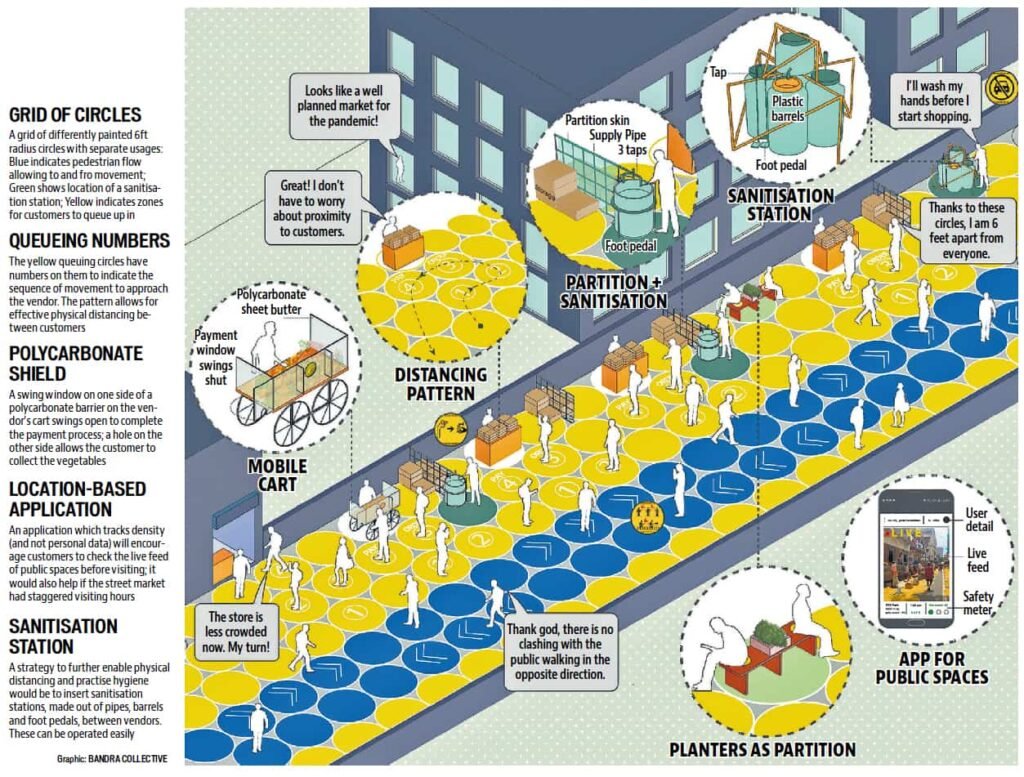- test : test
- test2 :
Urban Design in times of Covid-19: Imagining a post-pandemic city
(this is an except from an article that first appeared in the Hindustan Times 26-07-2020
The colonial authorities created an organisation with the sole purpose to redesign what was then Bombay to improve its sanitary and living conditions. The planned opening of the suburbs was, in fact, a result of this. Today, coronavirus has forced us to take a hard look at our cities, again. HT reached out to urban designers and architects (Manit and Sonali Rastogi from Morphogenesis, the Bandra Collective, and Mriganka Saxena & Puneet Khanna, founders, City Analytics & Habitat Tectonics Architecture and Urbanism), to re-imagine and decongest four key spaces of our lives: a classroom, a street market, an office and a congested residential area. A look at their designs and innovations.
Street Market in times of Covid-19: Managing customers with DIY, low-cost design solutions
Pali Market in Bandra west is, in many ways, a typical Mumbai experience. Unlike other market places with demarcated areas for different produce — a square for the fish mongers and meat sellers; another for the vegetable sellers; a separate lane for grocers and dry goods, and quite another for clothes or plastics — this market includes everything from restaurants to a mutton shop and vegetable and fruit vendors on a 200-metre stretch that connects St Andrews Road on one end, to Dr BR Ambedkar road, on the other.
With this market as the basis of our illustration, and using a tactical urbanism approach [where architects / designers work with municipal authorities and local political representatives] we have developed economical, scalable and modular design interventions that can be adopted in public places in different combinations.
We’ve envisioned a grid of six-foot circles. Differently painted, they have separate usages: here, blue indicates pedestrian flow, green, a sanitation station, and yellow, zones for customers to wait. The queuing circles have numbers on them to indicate the sequence of movement to approach the vendor. As a further precaution for street vendors, we have designed a polycarbonate sheet barrier for their vegetable vending cart which also provides a separate space for the person selecting the vegetables and the person paying for it. A window on one side of the barrier can be swung open to complete the payment process.

Other strategies to enable physical distancing includes insertion of sanitisation stations and planters as partitions. Putting a sign with text is not enough; simple, tactical design measures are more communicative in guiding people.
These interventions in this space go hand-in-hand with a pedestrianisation of the market, which will help decongest it. We’re also proposing a simple location-based application which tracks density (and not personal data) to encourage citizens to check the live feed of public spaces before going, hence empowering them to know the risks beforehand and make informed decisions.
Overall, the modular approach is scalable and can easily be applied to street markets, parks and other public spaces around the city. We have already implemented such a grid of circles at Bhaji Galli, a market in Grant Road with the assistance of Brihanmumbai Municipal Corporation officials, and aim to scale the initiative around the city in the coming weeks.
Bandra Collective, is a collaboration of six architectural firms,is a not-for-profit urban design think-tank based in Mumbai, comprising of architects and designers who seek to transform public spaces through design thinking
